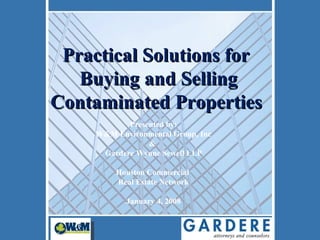Practical Solutions For Buying And Selling Contaminated Property
- 1. Practical Solutions for Buying and Selling Contaminated Properties Presented by: W&M Environmental Group, Inc & Gardere Wynne Sewell LLP Houston Commercial Real Estate Network January 4, 2008
- 2. Full service environmental consulting firm with offices throughout Texas. Leading Provider of environmental due diligence to real estate lenders, brokers, and investors. 90 VCP/IOP Sites 10 MSD Sites
- 3. Environmental Practice Group has 17 attorneys in Houston and Dallas Degrees in Engineering, Geology and Health Sciences Assist clients in closing real estate deals with potential environmental issues. Experience with VCP, IOP and MSD Programs Extensive Environmental Litigation Experience in state and federal court
- 4. #1 Make Money $$$ #2 Limit liability from off-site Third Party Lawsuits #3 Avoid future problems during re-sale of property. #4 Allows you to negotiate price and timing with seller. #5 You buy it, you own it ŌĆō the good with the bad.
- 5. Contamination identified during Environmental Due Diligence - Phase I ESA, Phase II, and/or asbestos survey. Contamination will impact value of property, the question is how much. Buyer, seller, and lender generally have differing views on the impact from contamination and resulting costs. Common sources of contamination are underground storage tanks (USTs), dry cleaners, and industrial facilities. Property Contamination
- 6. Voluntary Cleanup Program (VCP) Municipal Setting Designation (MSD) with VCP Innocent Owner/Operator Program (IOP) Dry Cleaning Remediation Program (DCRP) Leaking Petroleum Storage Tank Program (LPST) Corrective Action Program Cleanup Strategies for Contaminated Properties
- 7. Must meet cleanup criteria for all contaminants and all media. Use risk-based strategies whenever possible, limiting physical remediation. At completion, property owner obtains Certificate of Completion, which is transferred to future owners and serves as a release from future liability. Closed VCP sites have remained closed with very few exceptions.
- 8. Recent legislation that reduces or eliminates groundwater and to some degree soil cleanup. MSD ordinance is adopted by municipality that restricts groundwater use. Houston ordinance effective November 1. Excellent for chlorinated solvent sites (dry cleaners) that were difficult, if not impossible, to clean up. Much lower costs to close sites compared to traditional monitoring and/or long-term groundwater treatment. Used in conjunction with VCP to get TCEQ approved ŌĆ£closureŌĆØ and maximum price for property. Municipal Setting Designation (MSD)
- 9. Used for properties contaminated from off-Site source ŌĆō owner did not ŌĆ£cause or contributeŌĆØ to contamination. Must collect sample(s) to prove Site is impacted. IOP applicant is not responsible for monitoring, cleanup, or closure of the contamination. Certificate issued by IOP is not transferable. However, state generally approves after re-submittal and fee. IOP does not eliminate issue with on-Site contamination that impacts construction activities.
- 10. State fund to assess and remediate sites contaminated by perchloroethene from dry cleaners. $5,000 deductible State contractor conducts investigation and cleanup based on state ranking. State response may be slow and state may re-shuffle site to lower priority as more sites come into program. Low cost option that eliminates on-going consulting fees (ŌĆ£shelfŌĆØ site); but not likely a final remedy.
- 11. Allocating the risk by the structure of the Deal Designating a responsible party Indemnification/release issues Escrow Insisting on environmental closure What cleanup level? Timing of closure? Consideration of land use restrictions to aid closure Insurance Access issues Managing Environmental Liabilities That Come And Go With The Deal
- 12. Allocating the risk by the structure of the Deal Arbitration/Mediation considerations ŌĆ£ As-isŌĆØ clauses Post-transaction issues Communications/notices with buyer/seller Delivery of closure notice, documents, certifications Public Nuisance: could you be buying a lawsuit? DALLAS 1846896v1 Managing Environmental Liabilities That Come And Go With The Deal
- 13. Thorough Due Diligence Look for liability protection from the government (state and federal) State programs do not generally provide protection from private party litigation Weighing the likelihood of litigation and the success of litigation is a key part to any deal Who will clean up? How much? When? Need excellent coordination and cooperation between the business, technical, and legal teams
- 14. W&M Environmental Group, Inc. Michael Whitehead [email_address] Phone: 972-516-0300 www.wh-m.com Gardere Wynne Sewell LLP Cindy Bishop [email_address] Phone: 214-999-4506 713-276-5303 www.gardere.com W&M Free Monthly E-Newsletter Contact Information













![W&M Environmental Group, Inc. Michael Whitehead [email_address] Phone: 972-516-0300 www.wh-m.com Gardere Wynne Sewell LLP Cindy Bishop [email_address] Phone: 214-999-4506 713-276-5303 www.gardere.com W&M Free Monthly E-Newsletter Contact Information](https://image.slidesharecdn.com/practicalsolutionsforbuyingandsellingcontaminatedproperty-12833787232889-phpapp01/85/Practical-Solutions-For-Buying-And-Selling-Contaminated-Property-14-320.jpg)